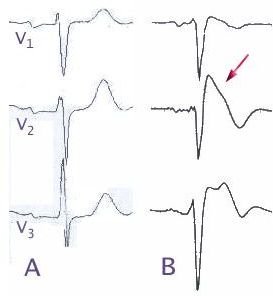Brugada Syndrome and Brugada Symptoms
Brugada Symptoms
Brugada symptoms can occur at any age - from infancy to old age - but they typically occur in adulthood. The disorder causes arrhythmia - abnormal heartbeats - where the bottom chambers of the heart (ventricles) beat so fast that blood cannot be circulated effectively around the body. And if the heart is not reset within a few minutes an individual can die. The symptoms of Brugada include: -
- Abnormal heartbeat
- Seizures
- Fainting
- Breathing difficulties
- Cardiac arrest
The complications tend to occur when a person is at rest or asleep, and the condition may well explain some instances of sudden infant death syndrome (SIDS) in babies and children, and sudden unexplained deaths in adults.
It is not known how prevalent the condition is because not every death by Brugada is described as such. However, according to the U.S National Library of Medicine an estimate of incidence is 5 in 10,000 people worldwide. And it appears that Brugada is more common amongst people of Asian ancestry.
Brugada Syndrome Causes
Mutations in the SCN5A gene on the short arm of chromosome three can cause Brugada syndrome. The genetic faults have been discovered in fewer than one third of cases. To date more than 150 mutations have been discovered in this gene.
SCN5A stands for sodium channel, voltage-gated, type V, alpha subunit. It provides instructions for making a sodium channel in cardiac muscle cells. The channels open and close to control the flow of sodium ions into cardiac heart muscles. Sodium channels change the electrical properties of these cells, and as such are involved in signaling the start of each heartbeat. There are also other genes involved in the onset of the disease.
In 2007 scientists from the University of Pittsburgh School of Medicine discovered another gene responsible for Brugada - GPD1-L. It is a trafficking gene that ensures that a sodium channel reaches the cell membrane. Mutations of the gene interfere with this process and thereby contribute to potentially fatal arrhythmias.
For those people whose condition is not due to faulty genes, the cause is generally unknown. In some cases drugs that bring about altered heart rhythms may be the cause, including medications used to treat angina, depression, and high blood pressure.
Brugada Syndrome Inheritance
Brugada syndrome follows an autosomal dominant pattern of inheritance, which means that one abnormal version of the gene is enough to cause the condition. If just one parent has the mutated gene, then each child will have a 50% chance of inheriting the disorder.
Brugada syndrome can also be caused by spontaneous new mutations in the SCN5A gene, where a child’s parents have no history of the disorder.
Brugada Syndrome Treatment
Antiarrhythmic drugs do not protect against sudden cardiac death and so treatment relies on an implantable cardioverter-defibrillator. This continuously monitors heart rhythm, and will recognise arrhythmias and treat them in situ.
